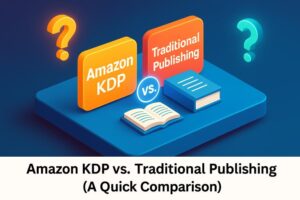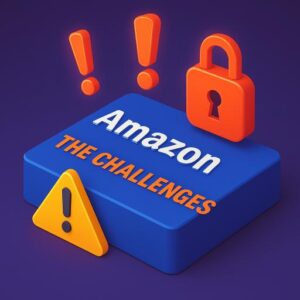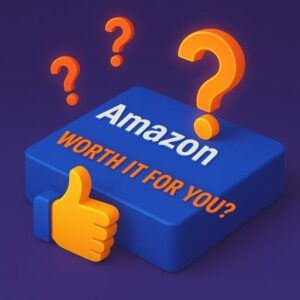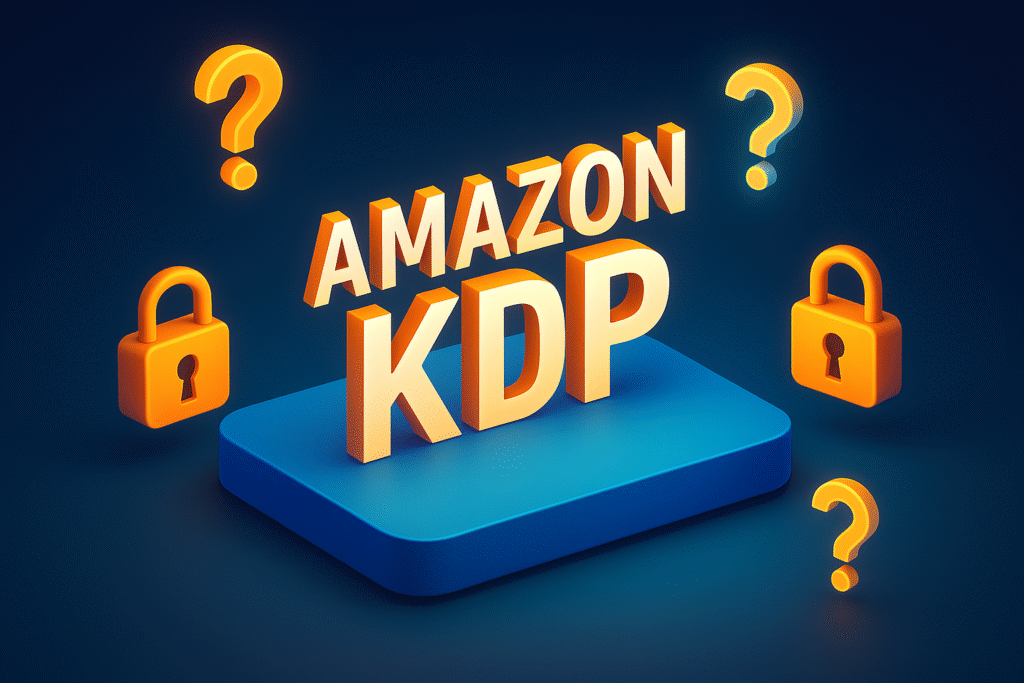Introduction
Ever dreamt of publishing your own book and reaching millions of readers worldwide? With Amazon KDP (Kindle Direct Publishing), thousands of writers are doing just that. But is Amazon KDP worth it in today’s competitive landscape, or is it an oversaturated mirage? In this post, we’ll dive into the real deal behind Amazon’s self-publishing platform – from the enticing benefits to the hard truths – so you can decide if it’s the right path for your author journey.
Amazon KDP launched in 2007 and revolutionized publishing by offering a simple way for authors to publish both eBooks and paperbacks globally, bypassing traditional gatekeeperssellersprite.com. In just a few clicks, you can upload your manuscript, set a price, and see your book listed on Amazon’s Kindle Store. This ease and accessibility have opened the doors for countless new authors. But on the flip side, success doesn’t come easy. Let’s explore how KDP stacks up, what you gain, what you sacrifice, and ultimately whether it’s worth your time and effort.
An author at work on their next book. Amazon KDP makes it easy to self-publish – but navigating its challenges is key to success.
Amazon KDP vs. Traditional Publishing (A Quick Comparison)

One way to gauge KDP’s value is to compare it with the traditional publishing route. Here’s an overview of how self-publishing on Amazon differs from going with a traditional publisher:
| Aspect | Amazon KDP (Self-Publishing) | Traditional Publishing |
|---|---|---|
| Barrier to Entry | Very Low – Open to any author. No gatekeepers or approval neededsellersprite.com. | High – Requires finding an agent or publisher; many submissions get rejected. |
| Speed to Market | Fast – Books can be live within days of completionsellersprite.com. | Slow – Can take months or years from book deal to publication. |
| Creative Control | High – You control content, cover, pricing, and all rightssellersprite.com. | Limited – Publisher often controls editing, cover design, pricing, and retains rights. |
| Royalties | Higher Potential – Up to 70% on eBookssellersprite.com (and ~60% on paperbacks minus print costssellersprite.com). | Lower – Around 5–15% royalty is common for traditionally published authors, since the publisher takes the lion’s share. |
| Costs | No Upfront Publishing Cost – KDP is free to usezonguru.com, but authors often invest in editing, cover design, and marketing. | No Direct Cost to Author – Publisher covers production/marketing, sometimes giving an advance. (But cost is the time/effort to land a deal.) |
| Distribution & Reach | Global Amazon Reach – Your book is available on Amazon’s worldwide stores (which account for about 50% of print and 68% of e-book sales in the USzonguru.com). Print-on-demand means even paperbacks are sold globally without inventoryzonguru.com. | Bookstores & Beyond – Traditional publishers can get your book into physical bookstores and libraries, a reach self-published eBooks often struggle with. However, Amazon’s dominance means traditional publishers also rely heavily on Amazon for sales. |
| Marketing Support | DIY Marketing – You’re on your own. While KDP offers some tools (Kindle Unlimited, limited promos), you must drive the advertising, social media, etc., to get noticedsellersprite.com. | Publisher Support – Some marketing and publicity may be handled by the publisher (though debut authors may still need to promote themselves). |
In short: Amazon KDP gives you full control and higher royalties, but also full responsibility. Traditional publishing can offer prestige and support but comes with gatekeepers, lower pay slices, and far less control. Now, let’s break down the specific pros and cons of using KDP.
Why Amazon KDP Attracts Authors (The Pros)
1. Easy Entry & Fast Publishing: KDP makes self-publishing incredibly simple and quick. There’s no approval committee – anyone can create an account, format their book, and hit publish. Your eBook can go live in 24-72 hours, and paperbacks in just a couple of dayssellersprite.com. For writers who want to seize an opportunity or publish on their own schedule, this speed is a huge plus compared to waiting years for a book deal.
2. High Royalties: The earning potential per sale on KDP is highly attractive. Authors earn 70% royalties on eBooks priced between $2.99 and $9.99sellersprite.com (35% if outside that range). By contrast, many other distributors or publishers offer much lower cuts – sometimes under 20%zonguru.com. For print books, KDP pays 60% of the list price (minus printing costs) for paperbackssellersprite.com. This means if you price a paperback at $12, about $7.20 minus print cost goes to you. Such rates are significantly higher than the ~10% (or whatever small percentage) a new author might get through a traditional publishing contract. In fact, Amazon’s model was a game-changer: it **“empowers authors” with both creative control and higher royalties than traditional deals】sellersprite.comsellersprite.com.
3. Global Audience Reach: Amazon is the world’s largest book retailer, which gives KDP authors instant access to a massive reader base. Amazon now accounts for roughly half of all print book sales and well over two-thirds of eBook sales in the U.S.zonguru.com. When you publish on KDP, your book is listed on all Amazon marketplaces worldwide, from the US and UK to Japan and India, at no extra effort. This global reach is something an individual author could never achieve alone in the past. Even traditional publishers can’t always guarantee international distribution for every title. KDP leveled that playing field by listing indie books right alongside bestsellers on Amazon’s storefront.
4. Full Creative Control: Self-publishing through Amazon means you’re the boss of your book. Want to set your novel’s price at $3.99 or run a free promo? Go for it. Prefer a particular cover design or title? It’s your call. Authors maintain complete control over content, cover, and marketing decisions, and you retain all rights to your worksellersprite.com. This freedom can be liberating – you can update your book anytime, fix typos, change keywords, or even swap covers if you realize something’s not working. By contrast, in traditional publishing, authors sign over rights and often can’t make changes without publisher approval. For many writers, especially those with a strong vision or in niche genres, this creative control is a big reason to choose KDP.
5. No Upfront Publishing Costs: It costs $0 to publish on KDP. Amazon does not charge any fees to upload and list your eBook or print-on-demand paperbackzonguru.com. This lowers the barrier for anyone to try publishing. (Of course, savvy authors will invest in quality editing, cover design, or advertising – but those costs are at your discretion, not mandatory platform fees.) The print-on-demand service means you don’t have to pay for print runs or manage inventory – Amazon prints each copy when it’s orderedzonguru.com. This is a huge financial advantage over vanity publishing of the past, where authors had to buy boxes of books. In short, KDP lets you publish with minimal financial risk.
6. KDP Select & Kindle Unlimited Exposure: By enrolling your eBook in KDP Select, you gain access to Amazon’s Kindle Unlimited (KU) program and other promotional tools. Kindle Unlimited is a subscription service with millions of subscribers who can read your book “for free” (you get paid per page read). This can greatly expand your reach if you’re an unknown author. In 2023 alone, Amazon paid writers over $575 million through the Kindle Unlimited Global Fundzonguru.com – a testament to how robust the KU reader base is. Many indie authors credit Kindle Unlimited for helping new readers discover their work. However, there’s a catch, which we’ll cover in the cons.
The Challenges of Amazon KDP (The Cons)

Despite the advantages, Amazon KDP is not a guaranteed ticket to success. Here are some harsh realities and downsides to be aware of:
1. Fierce Competition & Discoverability Issues: By removing barriers, KDP has flooded the market with books. Over 2.6 million new titles were self-published in 2023 alonezonguru.com. That means when you hit “publish,” you’re dropping your book into a sea of millions. Especially in popular genres (romance, mystery, self-help), competition is intense. As a new author, visibility is the toughest challengesellersprite.com. Your book will be one of many unless you actively make it stand out. Amazon’s store algorithms favor books that already sell well, so being discovered often requires strategic marketing. Simply put, “without tactical marketing efforts, your book will struggle to attract readers” amidst the crowdzonguru.com. This is the trade-off: KDP makes publishing easy, but selling is another matter entirely.
Millions of new books hit Amazon each year, creating a mountain of competition. Standing out on KDP often requires niche targeting and savvy marketing.
2. You’re Responsible for All Marketing: Traditional publishers have marketing teams (though authors are still expected to promote). On KDP, you shoulder 100% of the marketing burden. Amazon does provide some tools: you can run Amazon Ads, set up limited-time deals, or enroll in Kindle Unlimited for more exposure. But realistically, as an indie author you’ll likely be blogging, building an email list, posting on social media, pursuing book reviews, and possibly investing in ads, all on your own. It can feel like a second full-time job. Many new KDP authors underestimate this aspect. If you just upload a book and do nothing, chances are you’ll see minimal sales. Success stories on KDP (the authors earning thousands per month) almost always pair prolific writing output with persistent marketing and brand-building. Be prepared to hustle for every reader until you gain momentum.
3. Income Can Be Unpredictable (or Very Low): While the royalty rates are great, the actual royalties you earn depend entirely on sales – and there’s no guarantee of sales. The sobering truth is that a lot of self-published books sell only a handful of copies. A recent analysis showed many self-published writers make only around $150 per month on the low end, while a small fraction hit $20,000+ per month at the high endzonguru.com. That range is huge, and most authors land nearer the low end, especially with a single book. In fact, one KDP veteran quipped that most new authors’ first books are “a book, not The book” – more of a learning experience than a breakout hitreddit.com. It often takes multiple books and several years to build a substantial income stream on KDP. Royalties also trickle in on a delay (Amazon pays ~60 days after the month of sale) and can fluctuate seasonally. So if you’re looking for quick or stable money, KDP might disappoint. It’s better to view it as a long-term, entrepreneurial endeavor – one with potential for passive income over time, but requiring upfront effort and patience.
4. KDP Select’s Exclusivity Clause: Earlier we mentioned KDP Select (KU) as a promo opportunity. The downside is exclusivity. If you enroll an eBook in KDP Select, you cannot sell that eBook on any other platform (Barnes & Noble, Apple Books, Kobo, etc.) or even on your own website while enrolledsellersprite.com. The exclusivity term is 90 days (auto-renewing if you don’t cancel). This is a significant trade-off. It means leveraging Amazon’s massive audience but putting all your eggs in one basket. Some authors feel Kindle Unlimited readership is worth it; others prefer to “go wide” and sell on multiple stores to diversify income. There’s no one right answer, but be aware that Amazon makes you choose: greater Amazon visibility vs. broader distribution. This requirement can be especially limiting if you have a PDF or direct sale strategy, or a niche audience on another platform. It’s the price of tapping into Amazon’s subscriber base.
5. Amazon’s Changing Rules and Cuts: When you publish on KDP, you’re operating on Amazon’s platform, and they can change policies any time. For example, in mid-2025 Amazon announced a cut to paperback royalties – dropping the rate from 60% to 50% on paperback books below certain price thresholdsv13.net. This kind of change directly impacts authors’ income. (In that case, authors had to either raise their paperback prices or swallow a 10% royalty cut overnight.) Amazon also tweaks algorithms and terms of service occasionally, which can affect your book’s visibility or reviews. The bottom line is, you don’t have the leverage that big publishers do; you’re one of millions of KDP users. So while Amazon provides a great service, it’s not altruism – they will prioritize their business. Successful indie authors adapt to such changes and often advise not to rely 100% on Amazon. If you can, build an email list or alternate sales channels so that a policy change doesn’t sink your whole ship. As one observer put it: Amazon isn’t your enemy, but it isn’t your friend either – it’s a platform with rules that can change whether you like it or notv13.netv13.net.
6. Quality Control & Stigma: One more challenge is maintaining professional quality. With no publisher vetting your work, it’s up to you to ensure your book is well-edited and has a great cover. Unfortunately, KDP is rife with low-quality titles (from hastily written content to AI-generated spam). This means indie authors have to work extra hard to earn reader trust. Investing in a professional cover and editing is almost mandatory if you want to compete with traditionally published books. There’s also still a bit of stigma among some readers (and media) that self-published books aren’t as good. This is changing as more indie titles break out, but it’s something to be aware of. Essentially, you must bring your A-game in quality to stand out and prove your book is worth a reader’s time and money, especially when you’re unknown.
Key Insights: Is Amazon KDP Worth It for You?

After weighing the pros and cons, the big question remains: So, is Amazon KDP worth it? The honest answer is – it depends on your goals, expectations, and willingness to work for it. Here are some key insights and takeaways to help you make your decision:
-
KDP is Worth It if you crave control and direct access to readers. If you want to maintain your artistic vision, publish on your own timeline, and keep a bigger share of profits, KDP is a fantastic opportunity. It has democratized publishing, letting voices be heard that might never get a shot in the traditional systemsellersprite.com. Many authors have built loyal audiences and even full-time careers through KDP. For instance, niche genre writers, series fiction authors, or entrepreneur-authors selling expertise have thrived on Amazon by writing to market and engaging their readers. If you’re entrepreneurial and love the idea of running your own publishing business, KDP can absolutely be worth it.
-
KDP is not a golden ticket – it’s a platform. Think of Amazon KDP as a tool; what you get out of it depends on what you put in. Simply being on Amazon doesn’t guarantee readers. The platform gives you reach, but you must provide the push (through quality and marketing) to tap into it. One successful self-publishing coach explained it well: the market isn’t “too saturated” if you approach it smartly – the key is to find your niche audience. “If you’re marketing to everyone, you’re marketing to no one,” they advise. The trick is to focus on a specific niche or reader group and make the best book possible for thempublishing.com. By drilling down to what makes your book unique, you can stand out even in a crowded field. In other words, niche down to rise above. Authors who identify a hungry sub-market and serve it with quality content tend to find KDP very rewarding.
-
Be prepared to play the long game. It’s rare to strike gold with one book. The authors who find KDP “worth it” are often those who treat it like a marathon, not a sprint. They might publish multiple books a year, learn from each release, and slowly build a catalog that generates steady income. Keep in mind, readers on Amazon love series and familiar genres – building a brand (e.g. a detective series or a romance series) can snowball your success over time. Your first book might only sell a few copies (and mostly to friends and family), and that’s okay. Use it as a learning experience, gather feedback, and improve on the next. As one Reddit user encouraged a newbie: “Book 1 is a book, not The book. Just a stepping stone in the journey.”reddit.com If you embrace that mindset, KDP can be incredibly worth it as a long-term path.
-
Assess your strengths and resources. To decide if KDP is worth it for you personally, consider what you bring to the table. Do you have a knack for online marketing or a built-in audience (like a blog or YouTube channel)? Then you’re positioned to leverage KDP well. Are you willing to invest some money in professional editing or covers? That can greatly enhance your chances. On the flip side, if you’re a person who hates self-promotion or just wants to focus on writing while someone else handles the business side, you might struggle with KDP’s demands. In that case, seeking a traditional deal or a small press might align better with your personality. Success in self-publishing = quality writing + entrepreneurial effort. You typically need both. Evaluate if that equation appeals to you.
-
Hybrid approaches exist. Remember, it’s not always an either/or. Some authors start on KDP to build a track record and later attract a traditional publisher for a wider print release. Others use KDP for eBook/Kindle and simultaneously use print-on-demand services like IngramSpark to reach bookstores. Some publish on KDP but opt out of KDP Select to “go wide” on all platforms. The landscape is flexible. Amazon KDP is a tool you can incorporate into a broader strategy that suits your goals. The key insight is: Amazon is too big to ignore (it’s essentially half the book market or more), so at minimum it’s worth considering KDP as part of your publishing plan, even if not exclusive.
Conclusion – Making Your Decision
So, is Amazon KDP worth it? For aspiring authors eager to get their work out into the world, KDP offers an unprecedented opportunity. It’s worth it in the sense that it grants you entry into the global book marketplace with no upfront cost, something unimaginable just a couple of decades ago. Many writers have used KDP to launch careers on their own terms – some even achieving significant fame and fortune without a traditional publisher. If you value creative freedom, higher royalties, and direct reader connection, you’ll likely find KDP a worthy endeavor.
However, it’s crucial to go in with eyes open. KDP is not a guaranteed success factory. It’s best for authors who are passionate and proactive – those willing to learn marketing, engage with readers, and continuously improve their craft. If you treat self-publishing like a business and a craft, the rewards can be significant over time. On the other hand, if you were hoping for a “write it and they will come” scenario, you may conclude KDP isn’t worth the effort.
Ultimately, consider your own definition of “worth it.” Is it about earning a side income? Reaching a handful of readers who need your story? Gaining experience for a future traditional deal? Amazon KDP can help with all of those, but it requires realistic expectations and work. The good news is that the resources to learn and succeed (online communities, courses, tools) are abundant, and the self-publishing community is very supportive.
Call to Action: Ready to take the leap? If you decide to give Amazon KDP a shot, start by researching your genre and seeing what successful indie authors are doing. We have plenty of other resources on self-publishing and book marketing – be sure to explore our blog for tips on topics like optimizing your Amazon book listing and launching your first book. And if you’re a seasoned KDP author, let us know: what has your experience been? Was KDP worth it for you? Share your thoughts or questions in the comments below – we’d love to hear your perspective and continue the conversation. Happy publishing!

